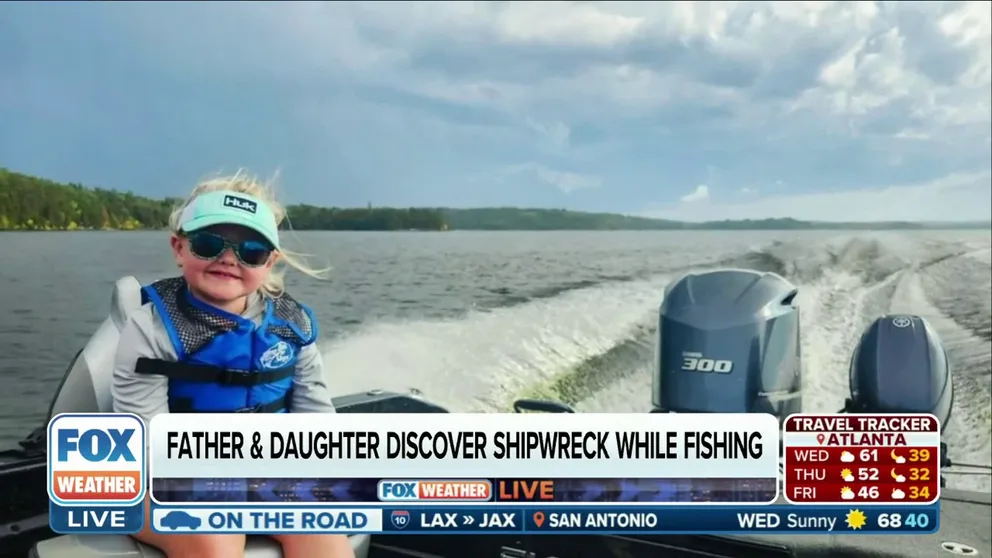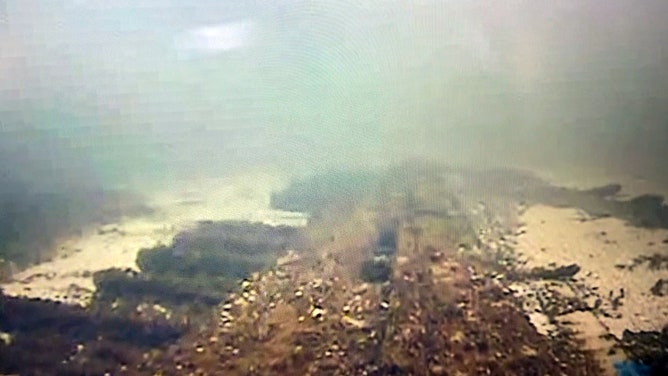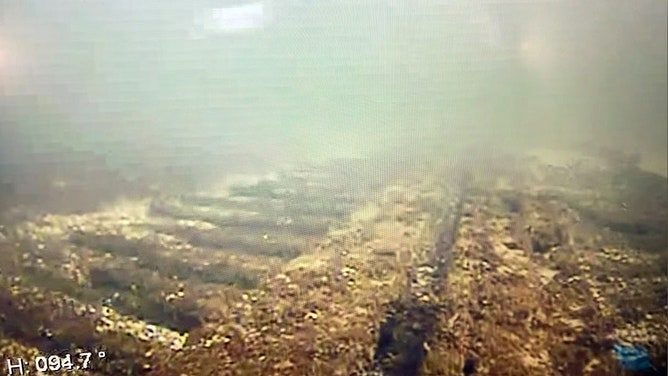Wisconsin father-daughter duo discovers likely 1871 shipwreck while fishing on Lake Michigan
Initially, Tim Wollak's daughter believed that they had spotted a rare “Green Bay octopus." However, it turned out that they had found the remains of a ship that may have run aground during the devastating Peshtigo Fire over 150 years ago, according to archaeologists' beliefs.
'Wow': Wisconsin father, daughter discover 1871 shipwreck
Tim Wollak and his daughter, Henley, discovered a 1871 shipwreck on Lake Michigan while fishing. The pair spoke to FOX Weather about their possibly historic discovery.
PESHTIGO, Wis. – Tim Wollak and his now 5-year-old daughter had a unique fishing experience on Lake Michigan this summer.
Initially, his daughter believed they had spotted a rare "Green Bay octopus" lurking in the freshwater lake on Aug. 13.
"I did have to squash that pretty quick because I don't know that she would want to swim in the water anymore if she thought there was an octopus that big out there," Wollak told FOX Weather on Friday.
According to archaeologists' beliefs, it turned out that the two had found the remains of a ship that may have run aground during the devastating Peshtigo Fire more than 150 years ago.
"Still to this point, I know there's been many people that have seen it. It's in shallow water. It's in a high-traffic area," Wollak said. "I'm sure people have seen it and probably saw the same thing I did, ‘Oh cool, a shipwreck. Somebody knows about this already. I’ll just take some pictures, enjoy it and move on."
HOW WEATHER TURNED THE GREAT LAKES INTO A SHIPWRECK GRAVEYARD
Wollak, of Peshtigo, Wisconsin, shared pictures and inquiries of the shipwreck to multiple Facebook groups. The post soon reached the Maritime Preservation and Archaeology Program and was subsequently investigated Dec. 4 with the help of a remotely operated vehicle, in collaboration with the Wisconsin Department of Natural Resources.
The Wisconsin Historical Society described the wreck as a wooden three-masted sailing ship in 8-10 feet of water.
"Although the identity of the wreck has yet been confirmed, the location and current available data fits with that of the barkentine George L. Newman," the agency said.
83-YEAR-OLD WRECKAGE OF LIKELY BRITISH WWII SUBMARINE DISCOVERED OFF NORWAY'S COAST
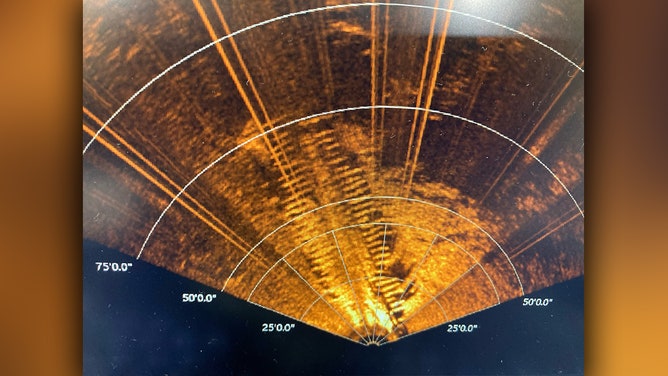
Sonar image of the George L. Newman.
(Wisconsin Department of Natural Resources)
Shipwright Benjamin Flint constructed the George L. Newman in 1855 in Black River, Ohio. The vessel was 122 feet in length, 26.3 feet in beam and had an 11-foot depth of hold, according to the historical society.
On the evening of Oct. 8, 1871, the barkentine was sailing through the thick smoke caused by the Great Peshtigo Fire, which is considered the deadliest fire in the history of the U.S. The ship was carrying lumber from Little Suamico when it ran aground on the southeast point of Green Island.
The smoke was so thick that the keeper of Green Island lighthouse, Samuel Drew, kept the light on even during the day. Drew rescued the crew, who stayed at the lighthouse for a week while they salvaged what they could from the wrecked ship, according to the historical society.
The ship was abandoned and covered with sand until it was located by the Wollaks this summer.
JUST HOW DEEP IS THE TITANIC WRECKAGE IN THE OCEAN?
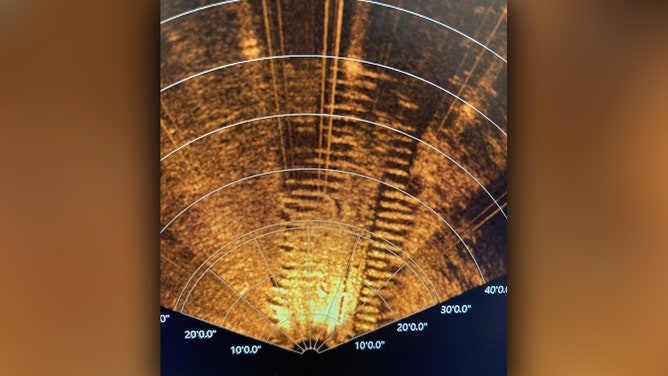
Sonar image of the George L. Newman.
(Wisconsin Department of Natural Resources)
The Wisconsin Historical Society's Maritime Preservation and Archaeology Program is planning to conduct a survey of a shipwreck in the spring. The survey will assess the site for possible inclusion on the National Register of Historic Places.
Until then, the father-daughter duo are unsure if they will ever have a more memorable experience while fishing together.
"I just hope that people can get out there and enjoy it but respect it, and because it is so accessible that they leave it for the historical society and those type of groups to document it and don't cause any damage to it," Wollak said.
Thousands of shipwrecks sit at bottom of Great Lakes
The lake beds of the Great Lakes are home to thousands of shipwrecks.
Lake Michigan alone is the resting place for an estimated 6,000 shipwrecks, according to Indiana Dunes National Park, which is located along the southern shore of Lake Michigan.
LOST CHAPTERS OF 125-YEAR SHIPWRECK FOUND IN LAKE HURON REVEAL AMERICA'S HISTORY OF TRADE
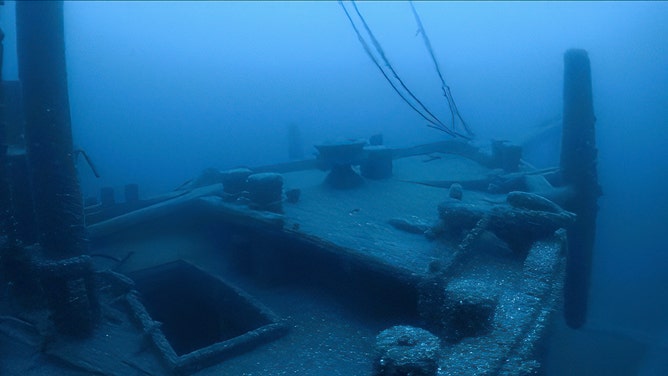
Ironton rests hundreds of feet below the surface with its three masts standing and rigging attached to the spars, and is magnificently preserved by the cold freshwater of Lake Huron. An anchor rests still attached on the bow of the sunken schooner barge.
(NOAA/ Undersea Vehicles Program UNCW)
The reason behind so many shipwrecks is that the Great Lakes have been used as a maritime highway for centuries.
"Most of the shipwrecks go back to the late 1800s or early 1900s when there was a lot more shipping going on the Great Lakes," Bruce Rowe, park ranger at Indiana Dunes National Park, told FOX Weather last month. "There's still quite a bit now, but there were thousands of ships or at least thousands of journeys by ships on the Great Lakes back then."
